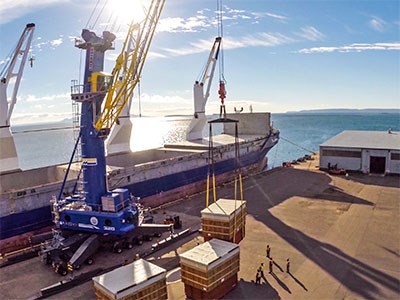Compared to the deep freeze and ice-choked waterways of the last two winters, it was practically summer sailing for the opening of the Port of Thunder Bay in late March.
The MV Tecumseh arrived in the western Lake Superior port, March 28, to load 20,000 tonnes of wheat and canola for Sorel, Que.
The following day, the season’s first saltwater vessel, the MV Federal Barents, pulled into port to load 21,000 tonnes of lentils bound for Turkey.
It was a day shy of tying the port record for the earliest arrival of an ocean-going vessel.
“We’re getting shipments in March,” said port authority CEO Tim Heney, “which is the first time in two years.”
With 83 per cent of the port’s tonnage being grain, the last two years have certainly been memorable ones for Thunder Bay.
The volume of grain that came through in 2015 – at 8 million tonnes – was its second best in 17 years, topped only by an historic grain haul from the previous year.
The combined totals of grain, coal, potash, dry bulk and other cargoes was close to 9 million tonnes for the year, “good, solid” numbers that Heney hopes that can be replicated this year.
“I have a hard time influencing grain. What we do control is the project cargoes at Keefer Terminal.”
Thunder Bay has historically been an export port for grain headed overseas.
But a few years ago, the port authority looked to drum up business by generating two-way traffic through project cargoes to service the Western Canada oil patch.
After handling 15 project cargoes last year, Heney has 25 on the schedule this year.
The port has enjoyed considerable success handling large modules and pressure vessels, along with a steady diet of wind turbine components.
The port has also landed some specialty cargoes, including equipment for the New Gold Mine near Fort Frances, and handled four shiploads of Norwegian wood pellets for the power plant in Thunder Bay.
Last year, for the first time in decades, Keefer stevedores were handling imported steel products.
“This is an interesting commodity because it goes into everything you build,” said Heney.
The first of four shipments of structural steel from Luxembourg – steel products no longer made in Canada – was scheduled to arrive in April, destined for the Alberta oilsands.
Activity in the oil patch may have slowed to a crawl, but the construction of new production facilities continues, said Heney.
Through careful coordination with shippers, CP Rail and FedNav, they’re utilizing empty lumber cars to ship steel west.
The diversity of cargo has been aided by the arrival of the Spliethoff Group, a new transatlantic freight liner service introduced in 2014 that is gaining traction with shippers.
“That’s been a good thing for us in opening up the market,” said Heney. “The Seaway is not having a great time because of the steel industry (slump), coal and iron ore (prices).
“Spliethoff has a new way of looking at things. It’s really taken cargo off of other supply chains.”
They’ve managed to siphon off cargo from Houston, the biggest breakbulk port in the U.S., and onto the lakes.
“Spliethoff has worked at attracting some of that through the lakes and the exchange rate sure helps,” said Heney.
The dismantling of the Canadian Wheat Board monopoly in 2013 has proved to be “very positive” for the port, said Heney, as grain that was once shipped to the Hudson Bay port of Churchill is being rerouted to Thunder Bay.
It caused a reshuffling of ownership of the eight grain terminals on the city’s waterfront.
All of the major grain-handling companies now maintain elevators in both Thunder Bay and Quebec, allowing ships loading grain in Thunder Bay to move to the same company’s elevators in the deeper water of the St. Lawrence to top off their loads headed to Europe and Africa.
Heney said all the elevators are fully automated but the additional tonnage has created 60 new jobs locally.
About the same time of the Wheat Board changes, the U.S. imported an historic record of European steel, which introduced more ships onto the lake and helped Thunder Bay coordinate its grain backhauls to Europe.
Fast turnaround times on rail cars and the restructuring of the Canadian Grain Commission has delivered millions in savings to ship through Thunder Bay.
“The planets all lined up at the same time, and then the (Great Lakes) water levels came back,” said Heney. “Who could have predicted that?”
Major infrastructure improvements are also in the offing for the port authority.
With no government subsidies, the authority survives on generating revenue from warehousing, and property development.
Over the last 10 years, the authority spent $14.5 million to buy a mobile crane, build a new 58,000-square-foot heated warehouse, acquire a CP intermodal yard and a shuttered grain elevator, and cleared some laydown space for cargo.
Their five-year capital budget calls for a further $17 million as part of a plan to configure the Keefer site.
Handling bigger and heavier cargo accentuates the need for more dock space. One warehouse will be removed and a newer one built further back on the property, which can serve as storage for local manufacturers and the forest industry.
The authority owns 350 acres of heavy industrial land with rail access, of which 200 acres is greenfield and “open to a lot of things,” said Heney, if the right opportunity comes along.




